It is ironic that the Ancient Egyptian tombs, once sealed,
were not intended to be seen by outsiders. Yet the highly
valued and often reproduced tomb decorations have had a
profound influence on art and have contributed significantly
to our understanding of the Ancient Egyptian culture. We
describe how recent advances in computational and digital
technology can add a new perspective to these marvels of
antiquity. Of particular interest to us has been the
development of a technique for digital reconstruction of
tombs, allowing for the creation of undistorted panoramic
views of tomb interiors that are simply unattainable with
traditional imaging methods. We have also applied similar
computational techniques to bring a new perspective to several
monuments of Ancient Egypt.
A Brief History of Ancient Egyptian Tombs
A Brief History of Ancient Egyptian Tombs
|
THE BURIAL CHAMBER OF SENNEDJEM
Shown to the right are a pair of photographs taken from each end of Sennedjem's burial chamber. The extensive distortions are due to the curved ceiling, the wide-angle lens, and the inherent effects of perspective projection. Under these conditions it is nearly impossible to obtain a complete distortion-free view of the burial chamber. In order to create a single distortion-free mosaic, we digitally estimate and remove these distortions [read more]. We begin with sixteen photographs with nearly full coverage of Sennedjem's burial chamber. The distortions in each image are removed and then seamlessly combined to form a complete and distortion-free view of the entire burial chamber as shown to the right (at 1/40 resolution). These images can then be combined with a three-dimensional computer model of the burial chamber giving an immersive experience of this chamber's beauty  |

|
|
THE BURIAL CHAMBER OF INHERKHAU
As with the burial chamber of Sennedjem shown above we have created, from 32 individual photographs, a single distortion-free mosaic of the burial chamber of Inherkhau. Shown to the right is the progression of the North wall (after removing geometric distortions). The final reconstruction shown below is at 1/16 resolution.  |
   |
|
THE PASSAGE OF REKH-MI-RA'S TOMB
As with the burial chambers of Sennedjem and Inherkhau we plan to create a single distortion-free mosaic of the passage of Rekh-mi-Ra's tomb (also transliterated as Rekh-mi-Re). Shown to the right is (1) an original image, and (2) the image after correcting for color/lighting imbalances, and (3) planar distortion. Shown below is the result of the first step in the reconstruction process. Shown is a composite of five separate images (at approximately 1/4 resolution -- these images were taken with a Kodak DCS PRO 14N digital camera with a 14 megapixel 1:1 CMOS sensor, using a Nikon 18-35 mm lens.) This scene depicts Rekh-mi-Ra, followed by attendants, inspecting craftsmen. Top register: jewelers and stone-vase makers; Second register: leather workers and rope makers; Third register: carpenters, statue-, furniture- and shrine-makers; Fourth register: metal workers, casting of copper door, vase makers, and weighing of gold and silver. For point of reference, the diagram below shows a top and cross sectional view of the the tomb [Norman de Garis Davies, The tomb of Rekh-mi-Re at Thebes]. The passage is 24m (78.7ft) long, 1.8m (5.9ft) wide, and reaches a maximum height of 7.3m (23.9ft). The shaded area in the sectional view roughly corresponds to the composite shown below. 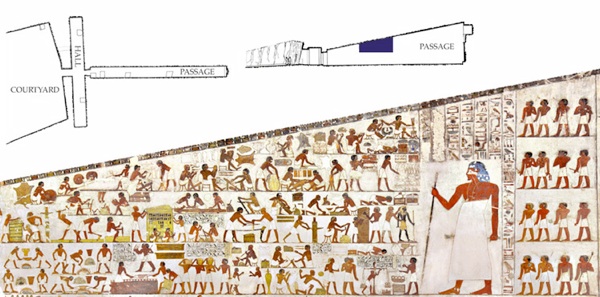
|
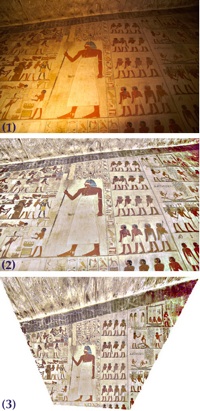 |
|
A BRIEF HISTORY OF ANCIENT EGYPTIAN TOMBS
Introduction The history of Pharonic Egypt spans nearly 3 millennia, starting around 3100 BC. Major accomplishments were achieved during 3 periods: the Old, Middle and New Kingdoms which lasted roughly 500 years (2700-2200 BC), 200 years (2000-1800 BC), and 500 years (1600-1100 BC). These periods were interrupted by intermediate periods where loss of central authority or foreign invasion led to decline. The ancient Egyptian civilization changed dramatically over these 1600 years, and many of these changes are reflected in how the tombs of the Kings and Queens, Nobleman, and Workers were built and decorated. The Royal Tombs The mastaba was the earliest and simplest tomb structure. It consisted of a single elevated platform and was built of mud-brick. These structures were not particularly elaborate and were not decorated. In the 3rd dynasty (Old Kingdom) Imhotep built the step pyramid (Fig. 1) for Zoser. This structure was the first all stone monument and was, of course, the inspiration for the true pyramids that followed, culminating into the pyramids of Giza, and in particular the great pyramid of Khufu. The pyramids were the major achievements of the 4th dynasty - approximately 2500 BC (Old Kingdom) - and were built for Khufu, Khafre and Menkaure (Fig. 2). These structures are truly awesome. The pyramid of Khufu, for example:
Because the king was revered as God, his tomb (the pyramid) was constructed to last forever, thus ensuring the continuing prosperity of the king in his afterlife. Like the early mastabas, the 4th dynasty pyramids had no decorations. The 5th dynasty (Old Kingdom) which saw the construction of more modest pyramids contained the first decorations. These decorations (Fig. 3 and 4) took the form of hieroglyphic writings - known as the Pyramid Texts - which provide guidelines and instructions on how to ensure safe voyage through the nether world and the eternal life thereafter. The construction of the pyramids disappeared during the first intermediate period and attempts for revival during the Middle Kingdom were far from successful. A very different approach was taken in the New Kingdom. Very elaborate, deep underground tombs were the norm. Interestingly these were constructed in an area dominated by a huge natural pyramid-shaped formation. Part of the reason for this change was to conceal the tombs from robbers. The New Kingdom saw perhaps the most glorious tombs. These tombs were decorated with scenes of the journey that the king (or queen) would take as they moved from this life to the afterlife and showing the King in the presence of major deities and making offerings to them. The scenes were highly colored and drawn from vignettes from the book of the dead and related subjects (Fig. 5). Each tomb, however, could look dramatically different as experimentation with different styles were undertaken. Shown in Fig. 5 are samples from the tombs of Tutmosis III, Horemhab, and Queen Nefertari. Shown in Figs. 6, 7, 8 and 9 are more photographs from the tomb of Tutmosis III. Shown in Figs. 10, 11, 12 and 13 are more photographs from Horemhab's tomb. And shown in Figs. 14 and 15 are more photographs from Nefertari's tomb. The Tombs of the Noblemen The noblemen (the ranking government officials) and high priests had decidedly more modest tombs. In the Old Kingdom, while pyramids were being built for kings, the noblemen were buried in mastabas. These mastabas were decorated with non-religious scenes depicting the daily life and official duties of the nobleman (Shown in Fig. 16, 17, 18, 19, 20, 21, 22 and 23 are scenes from tombs of Noblemen). Association of afterlife in the company of Gods was reserved for the kings. The noblemen's tombs served more as a place where offering for the deceased can be made. Starting with the Middle Kingdom and progressively through the New Kingdom democratization of religion began to be the norm. Tombs of the noblemen continued to depict their daily activities as well as scenes with strong religious overtones. Common people were expected to be in the company of Gods, who will see to it that they will be favorably judged and will make it safely through the arduous voyage in the nether word to emerge in paradise, where they will enjoy eternal life. The tombs of the New Kingdom's noblemen are beautifully decorated with such scenes. Unlike the royal tombs, which are confined to specific norms, the private tombs' decorations often break with these norms and are therefore artistically more pleasing. For example, shown in Fig. 24, 25 and 26 are scenes from Sennefer's tomb. The Tombs of the Workers A special type of tombs known from the New Kingdom are those of the workers who built the royal tombs in the Valley of the Kings. Although these were people of limited resources, they were well-equipped and skilled in tomb building. Because of their valued contribution to the royal families and noble elite to tomb construction, they were permitted to build their own "house of eternity". The tombs of the workers (in the Deir el-Median) were notably more modest than those of the kings or noblemen - typically 1/5 the size of the noblemen's tombs which themselves were 1/5 the size of the kings. These tombs, not constrained by long traditions, tend to be much more charming, and show an incredible diversity in their decorations. The tombs of Pashedu, Anher-Khau, and Sennedjem, all dating to the 19th Dynasty can be seen to be dramatically different (Fig. 27). Note also how the democratization of religion made its way down to the workers. |
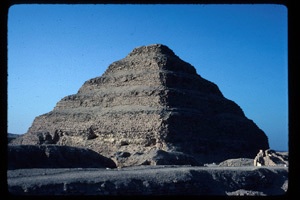 Fig. 1 - The step pyramid 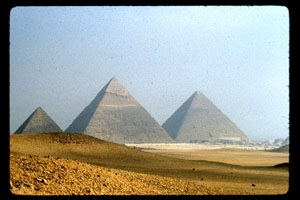 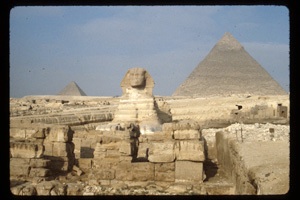 Fig. 2 - The pyramids of Giza 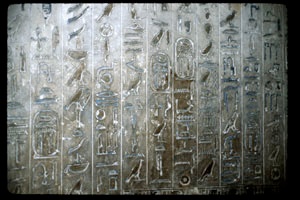 Fig. 3 - Early hieroglyphic writings from the tomb of Unas 
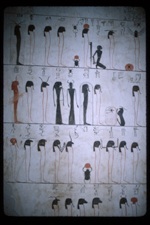 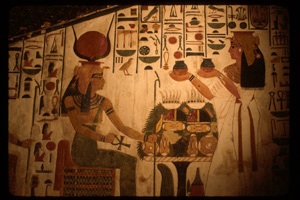 Fig. 5 - The royal tombs of, from top to bottom, Tutmosis III, Horamhab and Queen Nefertari (New Kingdom) 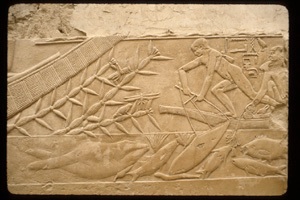 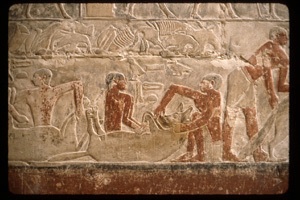 Fig. 16 - Depictions from tombs of Noblemen in Saqqara (Old Kingdom)  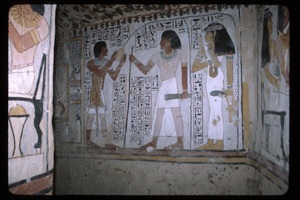 Fig. 24 - Depictions from the Nobleman Sennefer (New Kingdom)    Fig. 27 - The workmen tombs of, from top to bottom, the Anher-Khau, Pashedu, and Sennedjem (New Kingdom) |